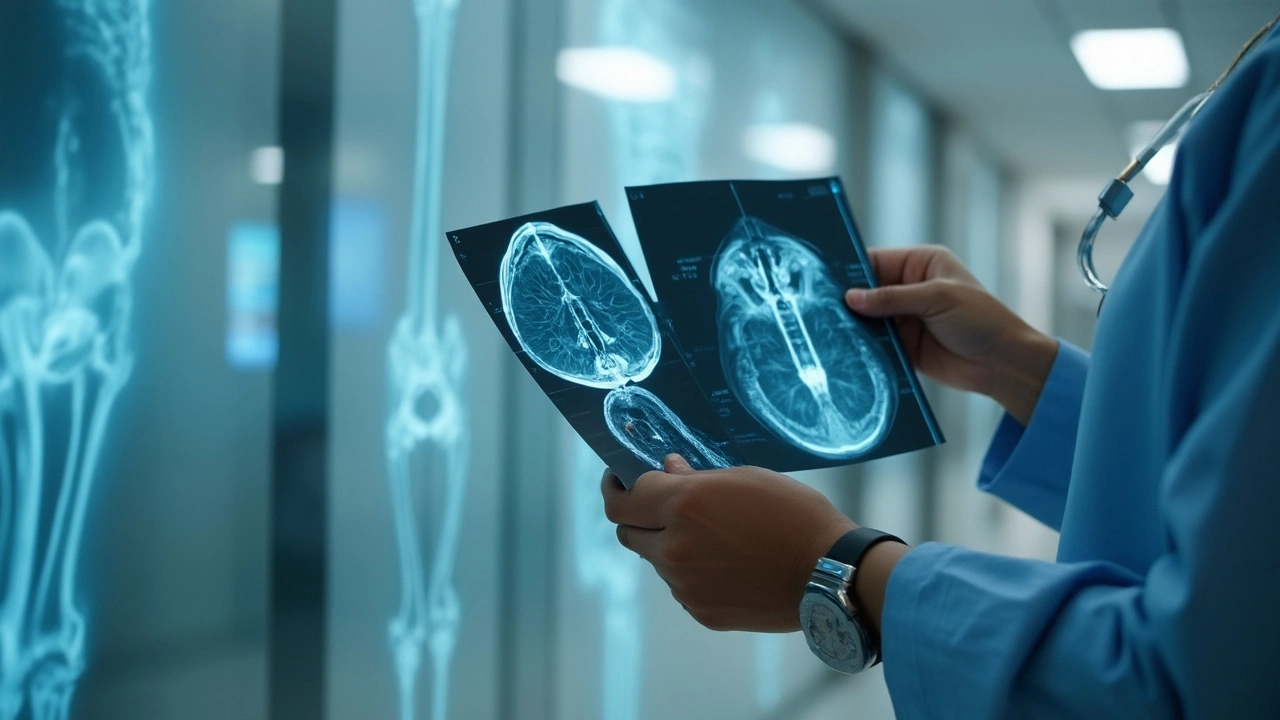
- May, 6 2025
- 0
If you've got pain in your bones or joints, figuring out what's really going on can feel confusing. There's no single test doctors use for everything. Your age, symptoms, and even your lifestyle all play a role in choosing the right one.
X-rays still rule when it comes to broken bones or injuries after a fall. They're fast, cheap, and everywhere—most hospitals have one in the house. But if you keep hurting or your joint feels stiff for no clear reason, your doctor may suggest more detailed scans. MRI catches things an X-ray can miss—like tiny tears in your ligaments or odd swelling inside joints. Sometimes, CT scans step in, especially if the problem is hard to spot with other tools.
Most people think only older folks need these tests, but active kids and young adults can need them too. Sports injuries, little-known infections, and genetic bone issues can sneak up on anyone. Ever heard that some vitamin shortages can mimic bone problems? Sounds bizarre, but it's true—blood tests sometimes help crack the mystery if scans look normal.
- When Should You Get a Test for Bones or Joints?
- X-rays, MRIs, and CT Scans—What's the Difference?
- Tests for Joint Pain and Swelling
- Tips for Getting Accurate Results
When Should You Get a Test for Bones or Joints?
Knowing when to get a bone test or joint test can save you time, money, and pain in the long run. Not every ache means you need a scan, but there are clear signs when you shouldn’t wait it out.
- If you hear a crack or pop followed by serious pain or swelling, go for an X-ray fast. Broken bones and some dislocations need quick action.
- If your pain sticks around for more than a week—even after resting, icing, or popping painkillers—it’s time to check in with an orthopedic specialist. Your body could be signaling more than a simple sprain.
- Repeated pain with movement or at night can mean something deeper like cartilage wear or a hairline fracture, which often isn’t obvious on regular exams.
- You lose range of motion—like if your shoulder can’t lift past a certain point or your knee won’t fully bend—don’t ignore it. Joint injury or inflammation could be getting worse.
- Notice weird lumps, hot spots, or red patches near a joint? Sometimes, hidden infections or even rare tumors can show up this way.
The Indian Orthopaedic Association says,
"Delays in getting the right scan for persistent joint pain often leads to more damage and longer recovery times."
Kids and teens aren’t in the clear either. Growth plate injuries and sudden swelling after a sports accident usually need special attention with X-ray or MRI.
| Reason for Test | Best Test Option |
|---|---|
| Sudden injury or fall | X-ray |
| Unexplained swelling or locking | MRI |
| Suspected fracture not seen on X-ray | CT scan |
| Chronic joint pain | MRI or blood tests |
Bottom line: if pain or swelling doesn’t get better, messes with your daily life, or seems strange, get checked. The right test can be the difference between a quick fix or months of nagging problems.
X-rays, MRIs, and CT Scans—What's the Difference?
It's easy to get lost with all the scanning options out there. So how do you know which bone test or joint test is actually right for your problem? Here's the breakdown of what each scan does best and when you might need them.
X-rays are the old-school workhorse. They're quick, cheap, and available in just about every orthopedic hospital. X-rays show your bones in black and white, making it easy to spot fractures, bone spurs, or big changes in joint space that come with arthritis. But they're not so great for tiny cracks or anything soft—like ligaments, muscles, or cartilage. If all you need is a basic look at your skeleton, an X-ray usually does the trick.
MRI (Magnetic Resonance Imaging) goes way deeper. Instead of using radiation, it uses magnets to make super-detailed images of bones and the stuff around them. MRIs are the best way to see things like:
- Torn ligaments or tendons (think rotator cuff or ACL injuries)
- Cartilage damage
- Swelling or bleeding that X-rays can’t pick up
MRIs take longer (sometimes up to an hour), and they’re pricier than X-rays. This test is usually what your doctor picks if your issue is more about joint pain, swelling, or soft tissue injuries.
CT scans (short for Computed Tomography) are like the perfect mix between X-rays and MRIs. They use a bunch of X-rays from different angles, then a computer puts them together for a 3D picture. CT scans are awesome for:
- Seeing complex broken bones (like in the spine, pelvis, or face)
- Spotting bone tumors
- Detecting infections deep in bone or joints
CT scans work fast—some take only a few minutes. But like X-rays, they also use radiation, so you don’t want to overdo them if you don’t have to.
Here’s a quick side-by-side look:
| Test | Best For | Downsides |
|---|---|---|
| X-ray | Fractures, arthritis, big bone changes | Misses soft tissue issues |
| MRI | Ligament/tendon tears, cartilage, soft tissues | Takes longer, more expensive |
| CT Scan | Complex fractures, tumors, bone infections | Uses radiation, not ideal for soft tissue |
Don’t be surprised if your doctor mixes these up or starts with one and moves to the next. Sometimes you need more than one type to get the clearest answer. If you’re worried about cost, time, or radiation, ask your doctor why they’re picking that particular test. There’s usually a solid reason behind it.

Tests for Joint Pain and Swelling
If your joints suddenly swell up or ache, figuring out the cause is key. The type of test your doctor picks depends on your symptoms and how long you’ve had them. There’s no one-size-fits-all answer here—sometimes you need more than one test to get the full picture.
X-rays can show if there’s any big damage in your joint, like bone spurs or clear arthritis. This is usually the first test because it’s quick. But if you’ve got lots of swelling or your joint test doesn’t match up with how bad your pain feels, your doctor might need something more detailed.
- MRI scans pick up injuries to cartilage, ligaments, or soft tissue—stuff you just can’t see on an X-ray. This is the go-to for sports injuries or when you suspect a tear that's not obvious yet.
- Ultrasound is great for checking if there’s extra fluid in the joint or to see inflammation. It’s also safe for kids and pregnant women since there’s no radiation.
- Blood tests come into play if infection or autoimmune issues (like rheumatoid arthritis) might be causing the mess. Something as simple as a CBC can point out infection behind your swelling.
- Joint aspiration sounds complicated, but it’s just taking a bit of fluid out of your swollen joint to check for infection, crystals (like in gout), or weird inflammation you can’t see on images.
Here’s a quick look at what each joint test is good for:
| Test Type | Best For | Notes |
|---|---|---|
| X-ray | Broken bones, severe arthritis | Cheap, fast, but misses soft tissue stuff |
| MRI | Ligament/cartilage tears | Costs more, but great for details |
| Ultrasound | Fluid, inflammation | Handy for guiding injections or aspirations |
| Blood tests | Infection, autoimmune issues | Good when nothing shows on images |
| Joint aspiration | Finding infection or crystals | Direct test—but a needle’s involved |
If your swelling comes and goes, try to get checked while it’s happening. That way your orthopedic or rheumatology team can spot what’s wrong in real time. Don’t ice or take lots of painkillers right before a hospital visit. It can impact how your joint shows up on certain scans and blood tests.
Tips for Getting Accurate Results
Getting the right answer from a bone test or joint test doesn’t just depend on the doctor or the machine—it actually depends on you, too. A few practical steps can help make sure your scan or X-ray gives the clearest, most useful info.
- Tell your doctor everything: Mention even weird symptoms, like tingling or swelling, or if you had an injury that seemed minor at the time. Details like how long you’ve had pain or stiffness help doctors pick the best test—be it X-ray, MRI, or blood work.
- Dress for the test: For MRI and CT, you'll usually have to take off watches, jewelry, belts, or anything with metal. Metal messes with the scans, so plan ahead and wear simple clothes.
- Mention allergies and implants: Some people react to the dye used in CT scans and MRIs, and certain metal implants (like pacemakers or rods) can cause trouble during the scan. Let your doctor know so adjustments can be made.
- Follow prep instructions closely: For some orthopedic tests, you might need to avoid eating or drinking for a few hours before or take certain meds beforehand. Not following the rules means unclear results or test delays.
- Stay still—seriously: Blurry images from moving during the scan can mean you have to do the test all over again. Ask for a pillow, support, or distraction if holding still is a struggle.
Some tests, like bone density scans, need you to avoid calcium supplements for 24 hours so you don’t get results that look better than reality. Forgetting this leads to a frustrating do-over.
If you’re worried about radiation from X-rays or CT scans, here’s a quick look at average radiation levels compared to everyday life:
| Test Type | Average Radiation Dose | Equivalent in Days of Natural Background Radiation |
|---|---|---|
| Single X-ray | 0.1 mSv | ~10 days |
| CT Scan (Chest) | 7 mSv | ~2 years |
| MRI | 0 mSv | None (no radiation) |
The bottom line—ask questions if you’re confused, keep your doctor in the loop, and follow the rules. These steps can push your bone and joint test results from "hmm, not sure" to "yep, that’s the answer."
Nikhil Verma
I'm a dedicated physician with a passion for exploring the intricacies of medicine, focusing on the unique healthcare challenges in India. I spend much of my spare time writing articles aimed at improving public understanding of health issues. Balancing my clinical practice and writing allows me to reach a wider audience, sharing insights and fostering a deeper appreciation for medical advancements. I derive immense satisfaction from both treating patients and engaging with readers through my writing.